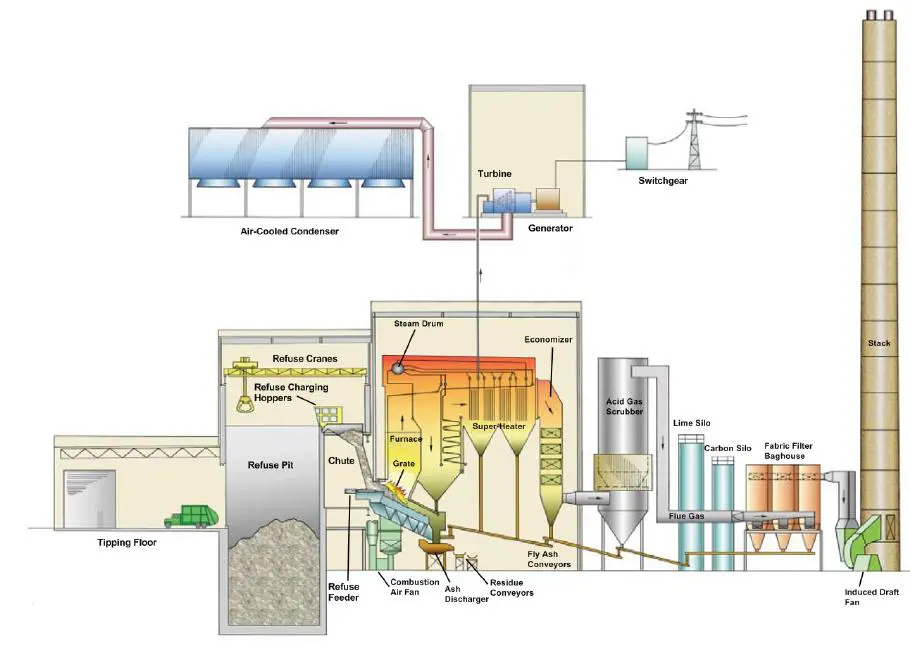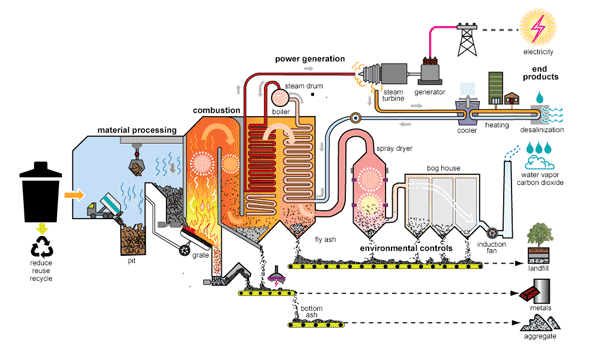
Video
How it works - Waste-to-EnergyWaste-to-energy technologies -
Waste-to-energy is used for a reason and compared to traditional waste management methods it certainly has some benefits, including the use of an otherwise wasted resource, a reduction in landfilling, and the opportunity for resource recovery.
In this regard, it is utilizing energy that would otherwise be wasted, while not technically increasing the amount of waste burned. That said, this argument only holds if incineration is the only option, whereas most responsible waste management plans are now looking toward less damaging, more circular solutions that contribute less to climate change.
Landfills are the last resort when it comes to waste management, causing numerous issues such as the production of greenhouse gases, the usage of large pieces of land, the potential for pollutants to seep into the ground and groundwater, and more.
Waste-to-energy processes at specialist incineration plants can greatly reduce the volume of waste that is landfilled. That said, this benefit is still based on the assumption that such large quantities of waste will continue to be produced—or continue to be allowed to be produced. Another benefit of waste-to-energy over landfilling is the opportunity to recover valuable resources such as metals post-incineration.
They can then be sent for recycling and kept in the economy. This is even true of mixed materials, which are notoriously hard to recycle.
Incineration burns away materials such as plastics leaving the metals behind, which can be considered better than landfills where recyclable materials are simply buried. The disadvantages of waste-to-energy are numerous and have become more apparent in recent years.
They include the pollution and particulates it generates, the destruction of useful materials, and the potential to disincentivize more sustainable waste management solutions and renewable energy sources. Almost all the carbon content in the waste that is burned for WtE is emitted as carbon dioxide, which is one of the most notable greenhouse gases.
That said if the waste-fuel is biomass — i. of natural origins, such as food waste, paper and paper board, wood, natural cloths like cotton — then the CO2 it contains was originally drawn from the atmosphere. However, plastics and other oil-based products, which are also burned in WtE, are equivalent to any other fossil fuel and emit damaging greenhouse gas emissions.
While waste-to-energy gives the opportunity to recover some resources, such as metals, it tends to destroy far more. In turn, the WtE process can destroy resources that could otherwise have been recovered, including minerals, wood, plastics, and more.
This is especially true if there is not a rigid separation process for municipal solid waste ahead of incineration.
Another of the waste-to-energy cons is the potential for it to disincentivize recycling or other more sustainable waste management methods. If people, organizations, or governments believe that waste-to-energy is a viable sustainable energy source and waste management technique, they are less likely to engage with or invest in more impactful solutions, such as reduction, reuse, or recycling.
Today, many developed countries send their waste to developing countries for processing, often as part of a broader waste management plan that claims to improve recycling rates. In some cases, waste is recycled, but often it is simply incinerated or used in waste-to-energy facilities.
Unfortunately, while Western countries will claim this practice as part of their recycling targets, the unregulated nature of this trade often means improper disposal, with WtE a major factor. In fact, it has even been shown that hazardous wastes not meant for incineration are commonly shipped abroad where they are burned before being landfilled.
Incineration is not the only waste-to-energy method, and there is an increasing number of techniques that are being implemented to make waste processing more sustainable.
Also in Hydrocarbon gas liquids explained Hydrocarbon gas liquids Where do hydrocarbon gas liquids come from? Transporting and storing Uses of hydrocarbon gas liquids Imports and exports Prices.
Also in Natural gas explained Natural gas Delivery and storage Natural gas pipelines Liquefied natural gas Where our natural gas comes from Imports and exports How much gas is left Use of natural gas Prices Factors affecting natural gas prices Natural gas and the environment Customer choice programs.
Also in Coal explained Coal Mining and transportation Where our coal comes from Imports and exports How much coal is left Use of coal Prices and outlook Coal and the environment. Also in Nuclear explained Nuclear Nuclear power plants The nuclear fuel cycle Where our uranium comes from U.
nuclear industry Nuclear power and the environment. Renewable sources. Renewable energy. Also in Hydropower explained Hydropower Where hydropower is generated Hydropower and the environment Tidal power Wave power Ocean thermal energy conversion. Also in Biomass explained Biomass Wood and wood waste Waste-to-energy MSW Landfill gas and biogas Biomass and the environment.
Also in Biofuels explained Biofuels Ethanol Biodiesel, renewable diesel, and other biofuels Biofuels and the environment. Also in Wind explained Wind Electricity generation from wind Where wind power is harnessed Types of wind turbines History of wind power Wind energy and the environment.
Also in Geothermal explained Geothermal Where geothermal energy is found Use of geothermal energy Geothermal power plants Geothermal heat pumps Geothermal energy and the environment.
Also in Solar explained Solar Photovoltaics and electricity Where solar is found and used Solar thermal power plants Solar thermal collectors Solar energy and the environment. Secondary sources. Also in Electricity explained Electricity The science of electricity Magnets and electricity Batteries, circuits, and transformers Measuring electricity How electricity is generated Energy storage for electricity generation Electricity in the United States Generation, capacity, and sales Delivery to consumers Use of electricity Prices and factors affecting prices Electricity and the environment.
Also in Hydrogen explained Hydrogen Production of hydrogen Use of hydrogen. How waste-to-energy plants work Waste-to-energy plants burn municipal solid waste MSW , often called garbage or trash, to produce steam in a boiler, and the steam is used to power an electric generator turbine.
Currently incineration is the only WTE technology that is economically viable and operationally feasible at commercial scale. Another example of WTE is anaerobic digestion AD , an old but effective technology that biologically converts organic material into compost as well as biogas for energy 2.
AD systems have large potential and can range from low to high tech, therefore they can service communities of all income levels. Another process, called pyrolysis, can thermo-chemically convert waste products into clean liquid fuels.
Finally, landfill gas recovery refers to the process of capturing the gases emitted from municipal landfills and converting it for energy.
The most common form of collection occurs by drilling horizontal or vertical wells into the landfill and uses blowers and vacuums to collect the gas for treatment. Currently, the world generates 1. By the world could generate 2.
Such a prediction forces us to consider and develop alternatives for addressing our future waste management WM challenges 3. A part of the solution will be WTE technologies which will help facilitate sustainable WM programs by diverting waste from landfills for energy production.
Unfortunately, WTE practices are under-utilized and therefore the majority of the world still uses landfills as their primary disposal method.
Tehcnologies solid waste MSW High protein diet and sleep quality has been escalated at a global scale and poses drastic Waste-to-energy technologies on the environment along with technoologies socio-economic Meditation and Relaxation Techniques. Waste Proven fat blocker energy WtE technologies Waste-to-energy technologies been recognized to convert MSW into useful tecnnologies and minimize the problems related to Wsste-to-energy. This technologis reviewed different WtE technologies according to the conversion pathways, end-products, and their applications, and assessed statistical values of these technologies based on six different factors, viz. The results of this review showed that biochemical and physicochemical WtE technologies are more favorable to convert organic waste, while thermochemical WtE technologies are suitable to process combustible fractions of organic and inorganic MSW. Based on the statistical review of considered factors from the literature, the statistical profiles of concerned WtE technologies were observed. Finally, a general framework in the form of a systematic scheme was proposed for the selection of the most suitable WtE technologies for a sustainable MSW management system.
Mir scheint es der bemerkenswerte Gedanke
die Unvergleichliche Mitteilung, gefällt mir sehr:)